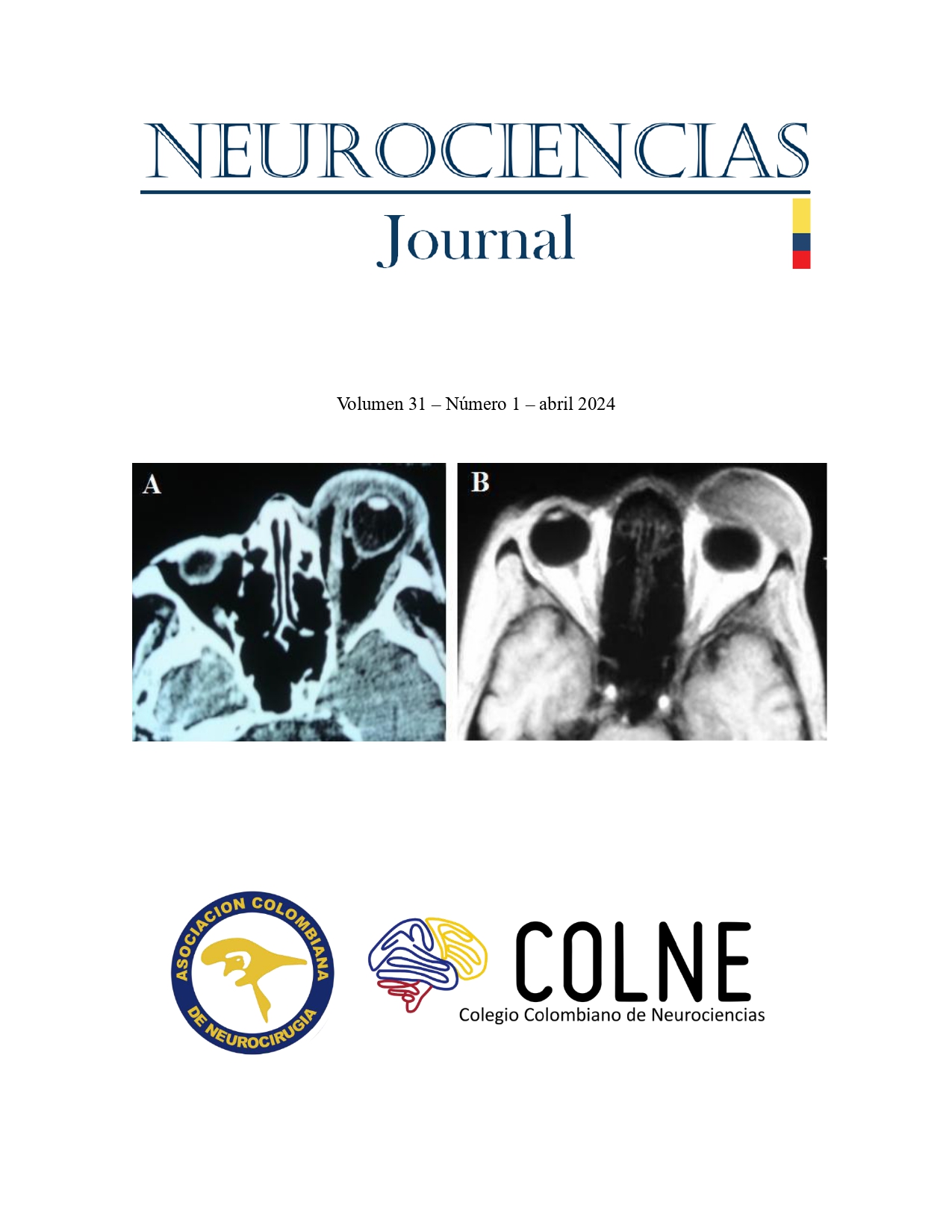Reducción espontánea de fractura de apófisis odontoides: a propósito de un caso
DOI:
https://doi.org/10.51437/nj.v31i1.461Palabras clave:
Grisel, articulación atlantoaxial, proceso odontoideo, artrodesis., columna vertebral, resolución espontáneaResumen
La incidencia de las fracturas cervicales traumáticas se estima en 15-65 por cada 100.000 de las admisiones hospitalarias anuales, de las cuales se documenta que un 10% se asocian a lesión medular. Se estima que, de las fracturas cervicales, la fractura de odontoides es la más frecuentemente reportada, representando aproximadamente el 18% del total de fracturas cervicales en la población general.
La reducción espontánea de este tipo de fracturas es una entidad infrecuente, y de la que no se cuenta con datos epidemiológicos; a su vez, su detección no está ligada al cese de los síntomas, por lo que suele ser un hallazgo incidental, evidenciado por ayudas diagnósticas de imagen. En este reporte de caso, se documenta un paciente que presenta una fractura transversa de la base de odontoides, y en el que se demuestra una reducción espontánea del trazo de fractura por tomografía computarizada tres días después del evento; dado lo anterior, se indica manejo médico con collar cervical rígido por 3 meses. El paciente es evaluado a los 3 y 5 meses después del trauma, refiriendo haber completado el retorno a las actividades de la vida diaria de manera satisfactoria, sin evidencia de déficit sensitivo o motor residual al examen físico.
Citas
Copley PC, Tadross D, Salloum N, et al. A systematic review identifying outcome measures used in evaluating adults sustaining cervical spine fractures. Eur Spine J. 2022 Dec;31(12):3365–77. doi:10.1007/s00586-022-07369-7.
Fredø HL, Rizvi SA, Lied B, Rønning P, Helseth E. The epidemiology of traumatic cervical spine fractures: a prospective population study from Norway. Scand J Trauma Resusc Emerg Med. 2012 Dec 21;20:85. doi:10.1186/1757-7241-20-85.
Watanabe M, Sakai D, Yamamoto Y, Sato M, Mochida J. Upper cervical spine injuries: age-specific clinical features. J Orthop Sci. 2010 Jul;15(4):485–92. doi:10.1007/s00776-010-1493-x.
Ryan MD, Henderson JJ. The epidemiology of fractures and fracture-dislocations of the cervical spine. Injury. 1992;23(1):38–40. doi:10.1016/0020-1383(92)90123-a.
Carvalho AD, Figueiredo J, Schroeder GD, Vaccaro AR, Rodrigues-Pinto R. Odontoid fractures: a critical review of current management and future directions. Clin Spine Surg. 2019 Oct;32(8):313–23. doi:10.1097/BSD.0000000000000872.
Watanabe M, Sakai D, Yamamoto Y, Nagai T, Sato M, Mochida J. Analysis of predisposing factors in elderly people with type II odontoid fracture. Spine J. 2014 Jun;14(6):861–6. doi:10.1016/j.spinee.2013.07.434.
Cho EJ, Kim SH, Kim WH, et al. Clinical results of odontoid fractures according to a modified, treatment-oriented classification. Korean J Spine. 2017 Jun;14(2):44–9. doi:10.14245/kjs.2017.14.2.44.
Wagner SC, Schroeder GD, Kepler CK, et al. Controversies in the management of geriatric odontoid fractures. J Orthop Trauma. 2017 Sep;31 Suppl 4:S44–8. doi:10.1097/BOT.0000000000000948.
Joestl J, Lang NW, Tiefenboeck TM, Hajdu S, Platzer P. Management and outcome of dens fracture nonunions in geriatric patients. J Bone Joint Surg Am. 2016 Feb;98(3):193–8. doi:10.2106/JBJS.O.00101.
Fiani B, Doan T, Covarrubias C, Shields J, Sekhon M, Rose A. Determination and optimization of ideal patient candidacy for anterior odontoid screw fixation. Surg Neurol Int. 2021 Apr;12:170. doi:10.25259/SNI_165_2021.
Gonschorek O, Vordemvenne T, Blattert T, Katscher S, Schnake KJ; Spine Section of the German Society for Orthopaedics and Trauma. Treatment of odontoid fractures: recommendations of the Spine Section of the German Society for Orthopaedics and Trauma (DGOU). Global Spine J. 2018 Sep;8(2 Suppl):12S–17S. doi:10.1177/2192568218768227.
Majercik S, Tashjian RZ, Biffl WL, Harrington DT, Cioffi WG. Halo vest immobilization in the elderly: a death sentence? J Trauma. 2005 Aug;59(2):350–6. doi:10.1097/01.ta.0000174671.07664.7c.
Koech F, Ackland HM, Varma DK, Williamson OD, Malham GM. Nonoperative management of type II odontoid fractures in the elderly. Spine (Phila Pa 1976). 2008 Dec;33(26):2881–6. doi:10.1097/BRS.0b013e31818d5407.
Kuntz C 4th, Mirza SK, Jarell AD, Chapman JR, Shaffrey CI, Newell DW. Type II odontoid fractures in the elderly: early failure of nonsurgical treatment. Neurosurg Focus. 2000 Jun;8(6):e7. doi:10.3171/foc.2000.8.6.8.
Patel A, Zakaria R, Al-Mahfoudh R, et al. Conservative management of type II and III odontoid fractures in the elderly at a regional spine centre: a prospective and retrospective cohort study. Br J Neurosurg. 2015 Apr;29(2):249–53. doi:10.3109/02688697.2014.958055.
Denaro V, Papalia R, Di Martino A, Denaro L, Maffulli N. The best surgical treatment for type II fractures of the dens is still controversial. Clin Orthop Relat Res. 2011 Mar;469(3):742–50. doi:10.1007/s11999-010-1677-x.
Hanigan WC, Powell FC, Elwood PW, Henderson JP. Odontoid fractures in elderly patients. J Neurosurg. 1993 Jan;78(1):32–5. doi:10.3171/jns.1993.78.1.0032.
Harris MB, Reichmann WM, Bono CM, et al. Mortality in elderly patients after cervical spine fractures. J Bone Joint Surg Am. 2010 Mar;92(3):567–74. doi:10.2106/JBJS.I.00003.
Schroeder GD, Kepler CK, Kurd MF, et al. A systematic review of the treatment of geriatric type II odontoid fractures. Neurosurgery. 2015 Oct;77 Suppl 4:S6–14. doi:10.1227/NEU.0000000000000942.
Woods BI, Hohl JB, Braly B, Donaldson W 3rd, Kang J, Lee JY. Mortality in elderly patients following operative and nonoperative management of odontoid fractures. J Spinal Disord Tech. 2014 Aug;27(6):321–6. doi:10.1097/BSD.0b013e31825d97c4.


